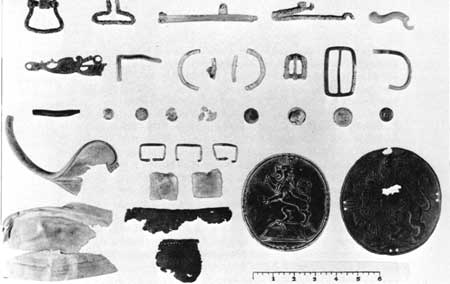|
YORKTOWN National Battlefield |
 |
Siege of Yorktown
(continued)

Representative objects recovered at the site of
British Redoubt No. 9 during the archeological exploration that preceded
its reconstruction.
CAPTURE OF REDOUBTS NO. 9 AND NO. 10. Prior to the attacks on these redoubts, Washington had ordered a feint on the extreme left against the Fusiliers Redoubt and also a demonstration at Gloucester Point to distract the enemy. For several days before the assault, allied gunners directed fire to weaken the positions, a fire that actually was not very harmful. The attacks were made at 8 o'clock, after dark, on October 14, in one of the most dramatic and heroic moves of the siege of Yorktown, and it proved to be a definite turning point in the operations.
Redoubt No. 10 was attacked by 400 Americans drawn from Lafayette's Light Infantry Division and commanded by Lt. Col. Alexander Hamilton, who, being officer of the day, had claimed this honor, when the assignment was first given to another. He was assisted by Lt. Col. Jean-Joseph Sourbader de Gimat, Lt. Col. John Laurens, and Maj. Nicholas Fish. The detachment moved out at the prearranged signal—the burst of six shells. The American soldiers carried unloaded muskets, as they advanced in darkness, since the assignment at hand was to be done with bayonets. On reaching their objective, they charged without waiting for the removal of the abatis (an entanglement of pointed tree tops and branches which ringed the redoubt), and thereby saved a few minutes—an interval that could have been costly. Within 10 minutes the position was in American hands with a loss of 9 killed and 31 wounded, according to Hamilton's own report.
As the Americans were moving out for their attack from the right end of the First Allied Siege Line, a party of 400 French soldiers led by Col. William Deux Ponts, with the Baron de l'Estrade second in command, launched an assault on Redoubt No. 9 from the temporary end of the second seige line. French casualties mounted when the detachment halted until the abatis was cleared, Then the cry was "on to the redoubt." A British charge was met by musket fire and a countercharge which took the French over the top, and the redoubt was theirs. Losses, however, totaled almost 25 percent, including 15 killed. The entire operation lasted less than half an hour.
LAST DAYS OF THE SIEGE. Immediately following the capture of the two key redoubts, troops moved up to resume work on the second siege line. Before morning, this line was extended all the way to the York River and incorporated the formerly held British Redoubts No. 9 and No. 10. Communicating trenches were opened to the First Allied Siege Line and, adjacent to Redoubt No. 9, a large American Battery was begun. On October 15, Ebenezer Wild recorded: "The works were carried on last night with such spirit that at daylight we found the parallel [line] extended quite to the river on our right and nearly completed. Batteries are erecting with great expedition."
With this turn of events, Cornwallis knew that he must act and act quickly or all would be lost. The web had tightened; and the destruction of his positions, plus sickness and casualties among his troops, made his situation critical, even perilous. Against the fully operating allied second line, he would be unable to hold out for 24 hours.
On the night of October 15—16, Cornwallis ordered an attack against the second line. This was launched, 350 strong, under Lt. Col. Robert Abercrombie at a point near the center of the line. It was a gallant sortie, yet it accomplished little, for, within a few hours, the guns which had been spiked by the British were again firing upon Yorktown.
On the night of October 16—17, Cornwallis ordered all of his effectives moved across the river to Gloucester Point. This, he thought, might enable him to make a breakthrough, which could be followed by a quick march north toward New York. The effort was futile. He was handicapped by a shortage of small boats, and a storm about midnight further interfered with the operation.
Early on the morning of the 17th he recalled those who had crossed the river. Later that morning he held a council with his officers, and at 10 o'clock a drummer in red, accompanied by an officer, was sent to a point on the parapet on the south side of Yorktown to beat a "parley."
Cornwallis' situation was hopeless. Casualties (killed, wounded, and missing) during the siege, it seems, numbered about 552 for the British, 275 for the French, and 260 for the Americans. Of these totals, more than one-fourth were killed in action. Yorktown was surrounded at close range, relief had not yet come, and the enemy was superior in men and firepower. In short, his position was untenable. Surrender was now the only alternative. Cornwallis himself reported: "We at that time could not fire a single gun. . . . I therefore proposed to capitulate."

|
|
Last Modified: Mon, Dec 2 2002 10:00:00 am PDT |


